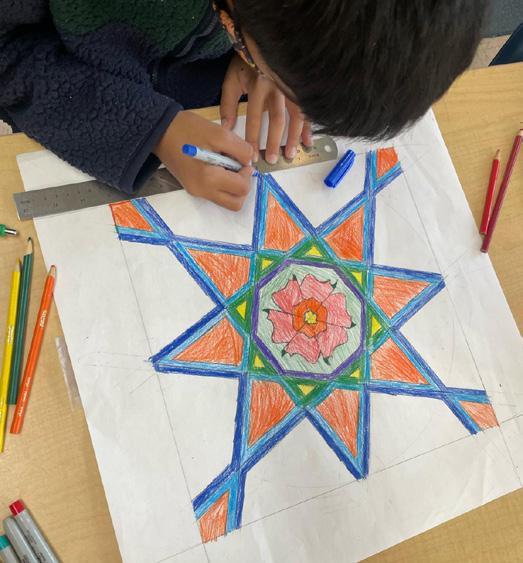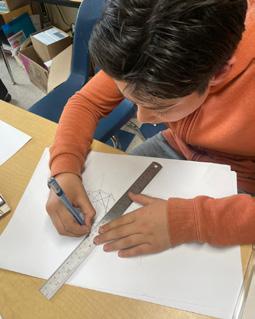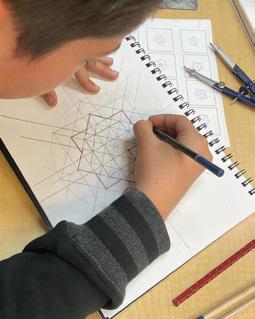
9 minute read
Unveiling Geometry's Cultural Tapestry
A Journey of Discovery & Connection
by Ola Elserwi
The ancient Greeks regarded drawing geometric constructions using only a compass and straightedge as essential for proving theorems. They discovered that this method facilitated problem analysis through the figures created, leading to solutions.
Throughout my educational journey, I stood out as the geometry geek among my classmates. Teachers often praised my ability to grasp and navigate geometric concepts swiftly. Growing up with an engineer for a father, I was led to believe that my aptitude for engineering stemmed from his genes, which seemingly multiplied the geometry neurons in my brain.
For months, my classmates and I dedicated ourselves to memorizing formulas, theorems, and prescribed steps for writing proofs. We did all this without truly critiquing or comprehending the process or applying our knowledge to meaningful contexts. This left us continually asking the question: Why are we learning this? For many, geometry became synonymous with daunting complexity, evoking memories of classes filled with perplexing theorems and bewildering formulas. While memorization may have aided some in solving certain problems, it did little to demystify geometry or foster a genuine affinity for the subject.
When the time arrived to pass on my geometry knowledge to my daughter, who was more inclined towards nature, art, and social activities, I experienced resistance. Her school's emphasis on rote memorization caused her to develop a fear of geometry, along with the belief that she was prone to making mistakes, which led her to find geometry difficult and boring. Despite my confidence, my attempts to assist her with personally tested tools, as well as hiring a geometry tutor, yielded tenuous results. As I wondered how to proceed, I questioned whether she would intuit concepts in geometry as effortlessly as I had, given our shared genetic makeup. However, her journey with geometry diverged from mine, marking a significant turning point for me.
In our three-dimensional, ever-changing world, children naturally develop a significant reservoir of geometric knowledge, which Montessori referred to as engrams. The geometry curriculum should harness this intuitive understanding to enhance and formalize students' foundational knowledge. Presenting geometry solely as a standalone, content-driven subject in a linear fashion, with time constraints and a rigid set of standards to cover, promotes premature abstraction. This approach can dampen students' enthusiasm and deprive them of the opportunity for self-paced exploration and a deeper understanding of the interconnectedness of life. Abstraction also severs the connection between geometry and its presence in nature, art, and human-made structures.
There is nothing in the intellect which is not first in the senses. — Aristotle
To facilitate a smooth transition to sensible abstraction, it is essential to 'scaffold' learners as they progress from simple to more complex levels of understanding, gradually shedding external support. This process involves building upon learners' existing knowledge to prepare them for new concepts. It necessitates a focus on enhancing learners' comprehension of geometric relationships, not because they lack the ability to grasp them, but because they require immersive, qualitative, and hands-on experiences over time to develop critical-thinking and visualization skills. This development occurs through reflection on actions, communication of observations and conclusions, and the cultivation of a robust vocabulary of geometric terms. In order to ensure that learners become confident and proficient, this approach must be integrated, dynamic, and tailored to leverage student culture, interests, language, available technology, manipulatives, and other resources.
Integrating geometry into our spiral curriculum cultivates interconnectedness across diverse learning domains, enabling children to explore its applications and forge meaningful connections between theoretical concepts and real-world experiences. By showcasing practical examples, such as architects utilizing circles to bolster structural resilience and environmental sustainability; plumbers determining offset angles to regulate fluid flow rates; and dentists employing angles for precise tool and material placement, students gain a deeper appreciation for the relevance of geometry in everyday life.
Tracing the historical evolution of geometric knowledge from practical applications to abstract theories reveals the contributions of various civilizations. The Greeks, for instance, developed theorems and proofs through structured discussions that emphasized clear argumentation, giving rise to Greek Logic. However, the roots of geometry stretch back to ancient Egypt and Mesopotamia, where practical applications flourished alongside agriculture, architecture, calendars, astronomy, and commerce, all facilitated by the presence of rivers. This progression prompted Aristotle to propose his peripatetic axiom, "There is nothing in the intellect which is not first in the senses," a concept later embraced by Montessori, who emphasized the integration of hands-on learning with intellectual pursuits.

By immersing students in the historical evolution of geometry, from practical applications to abstract concepts, we equip them with the skills to analyze and elucidate past challenges. This positions them to discern patterns in the contemporary landscape; thereby, offering a vital perspective for comprehending and ultimately resolving, present and future issues.
As I stepped into an Upper Elementary Montessori classroom, I was so excited about teaching geometry in a manner that enables and allows students (and me) to make discoveries through geometry's intrinsic cultural richness at different scales. Teaching geometry through its cultural lenses entails including diversity in anything that has to do with how people live, such as art, recreation, beliefs, languages, traditions, stories, and folklore, ways of organization, ways of interaction with the environment, and attitudes.
At the beginning of the year, I introduced the yin-yang design to my students, inviting them to share its story and significance. I found joy in hearing their narratives, and it gave them the opportunity to teach me. Yet, they needed more certainty regarding how to utilize a compass and straightedge to draw it. We analyzed the design, discussed each component, and then I guided them with some cues before stepping back to observe. What fascinated me was their dedication to perfecting and refining their personalized creations, as well as their "AHA" moments when they saw their ideas come to life, indicating their comprehension. Consequently, I adopted a construction-based learning approach throughout the year.
Thus, drawing comes to satisfy a need for expression, as does language; ...the effort to perfect such expression is very similar to that which the child makes when he is spurred on to perfect his language in order to see his thoughts translated into reality.
— Maria Montessori,
The Advanced Montessori Method, volume II, part V
Our exploration of geometric constructions extended to various cultures, including the Babylonians, Chinese, Indians, Islamics, Africans, Native Americans, Dutch, and numerous others. Delving into the narratives behind these constructions allowed my students to gain a profound insight into how our ancestors approached problems and persevered through trials, hardships, and triumphs to enrich the world. As they delved into their ancestors' contributions and stories related to geometry, my students found connections between themselves and their forebears, fostering a deeper appreciation for their cultural heritage.
I provided explicit instruction in construction techniques, covering the proper handling and use of a compass and straightedge, the angle and sharpness of pencils, types of leads, erasers, erasing techniques, hand placement, and cushioning under the paper. This equipped my students with the skills to think critically, visualize, critique, discover, conclude, and comprehend geometry concepts over time.
I vividly recall my students' fascination when I introduced certain constructions using only a compass and straightedge, such as the circumscribed circle of a square, finding the midpoint of a line, bisecting an angle, and doubling the borders of a hexagon. Some students were inspired to explore alternative techniques to execute these constructions beyond those I had taught. While this journey involved a considerable amount of trial and error, the joy and empowerment derived from their exploration and subsequent learning were evident. As I met with them to discuss their investigation, I also gained valuable insights.
In teaching geometric constructions, I offered multiple approaches and techniques to accommodate different learning styles. This ensured that students understood geometry as a field with a spectrum of ideas rather than a single solution. This approach encouraged my students to pursue their own research questions, develop innovative geometric designs, and delve into historical contexts.
Geometry transformed into a captivating treasure hunt as my students explored the intricate Islamic geometric con- structions and admired the beauty of biomorphic art, also known as Arabesque, from various regions and eras. This journey fostered divergent thinking, creative problem-solving, and the development of logical reasoning skills among my students. They became deeply engaged in investigating, experimenting, and creating their own constructions, sharing the joy of discovery with one another. Through geometric constructions, they delved into spatial relationships, properties of geometric figures, transformations and modeling, measurement, and deductive reasoning. This immersive experience allowed them to perceive the world through a geometric lens, truly encountering geometry in their everyday lives. They met geometry!


During the editing process of this article, an interesting event occurred: One of my students approached me seeking guidance on drawing various types of bridges. This prompted me to initiate a study unit on the historical aspects of bridges. To scaffold their learning journey, students completed a KWL chart—a graphic organizer that assists students in arranging information prior to, during, and following a unit or lesson, to express their background knowledge, interests, and inquiries regarding the topic. Among their curiosities were inquiries about the origins of bridges, their quantity, drawing techniques, construction methods, and materials utilized. Exploring these questions offers insight into their fascination with historical origins, pioneering figures, and the artistic aspects of design.
As I journey through the realms of geometry, my comprehension has matured, leading me to embrace a multidimensional approach to teaching that integrates language, art, history, and science with this discipline. Geometry serves as a unifying force, a universal language of expression that bridges diverse subjects and people together. It stands as a universal language capable of fostering peace and unity. Let us continue to delve into the cultural depth of geometry, recognizing its importance for humanity's collective understanding.
Over a decade ago, Ola Elserwi embraced the calling to become a Montessori teacher, infusing her pedagogy with creativity and passion. Today, as an Upper Elementary Montessori educator, she harmonizes her love for teaching with artistic expression, Islamic geometric designs, and biomorphic patterns.
Her accomplishments are helping the creation of pioneering Montessori Arabic language curriculum, adopted by schools across Egypt and beyond. In addition to academia, Ola finds solace in crafting intricate geometric designs, honoring her deep reverence for Islamic art and culture. When not shaping young minds or designing curriculum materials, she immerses herself in nature, traversing scenic landscapes, embracing physical activity, and exploring literature.










